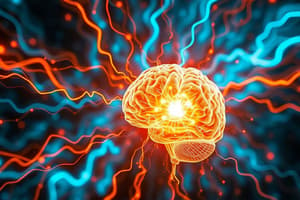Podcast
Questions and Answers
What happens when the density of surrounding items exceeds the critical density for individuation?
What happens when the density of surrounding items exceeds the critical density for individuation?
- It produces crowding effects that hinder attention movement. (correct)
- It enhances the ability to focus on a single item.
- It leads to easier movement of attention between items.
- It has no impact on attention allocation.
What is meant by 'object-based' attention?
What is meant by 'object-based' attention?
- Attention is allocated solely based on spatial locations.
- Attention can be distributed across non-overlapping visual fields.
- Attention is determined by the brightness of objects in the environment.
- Attention selects perceptual objects rather than just locations in space. (correct)
In the absence of a sufficiently high perceptual load, what is likely to occur?
In the absence of a sufficiently high perceptual load, what is likely to occur?
- Attention will remain focused on target events.
- Attention will spill over to non-target events. (correct)
- Attention will only process target events.
- Attention will cease to function entirely.
What did Neisser and Becklen's study demonstrate about selective attention?
What did Neisser and Becklen's study demonstrate about selective attention?
How does high perceptual load affect attention?
How does high perceptual load affect attention?
What aspect of attention does the spotlight metaphor struggle to account for?
What aspect of attention does the spotlight metaphor struggle to account for?
What is one of the results of crowding effects in visual perception?
What is one of the results of crowding effects in visual perception?
Which concept best resolves the early/late selection debate in attention studies?
Which concept best resolves the early/late selection debate in attention studies?
What was easier for subjects when tasked with reporting attributes from overlapping objects?
What was easier for subjects when tasked with reporting attributes from overlapping objects?
In the study regarding perception of height in figures, what affected task performance?
In the study regarding perception of height in figures, what affected task performance?
What does the concept of object-based attention suggest about visual processing?
What does the concept of object-based attention suggest about visual processing?
What effect did manipulating depth perception have on recognizing L shapes behind squares?
What effect did manipulating depth perception have on recognizing L shapes behind squares?
According to the findings referenced, what happens when subjects are required to attend to two objects occupying the same spatial location?
According to the findings referenced, what happens when subjects are required to attend to two objects occupying the same spatial location?
What does the term 'object-based representations' imply in visual attention studies?
What does the term 'object-based representations' imply in visual attention studies?
What was a significant finding from the studies referenced regarding attention allocation?
What was a significant finding from the studies referenced regarding attention allocation?
What conclusion can be drawn about occlusion and visual attention from the studies discussed?
What conclusion can be drawn about occlusion and visual attention from the studies discussed?
What does the evidence suggest about the movement of attention from one location to another?
What does the evidence suggest about the movement of attention from one location to another?
Which argument is made against the division of attention into multiple spots?
Which argument is made against the division of attention into multiple spots?
What conclusion did recent studies support regarding the ability to split attention?
What conclusion did recent studies support regarding the ability to split attention?
What did Castiello and Umilta argue regarding spatial attention?
What did Castiello and Umilta argue regarding spatial attention?
Which of the following best describes the findings of Kramer and Hahn (1995)?
Which of the following best describes the findings of Kramer and Hahn (1995)?
What is the primary debate regarding intermediate loci while attention shifts?
What is the primary debate regarding intermediate loci while attention shifts?
What was the stance taken by Yantis (1988) concerning attentional shifts?
What was the stance taken by Yantis (1988) concerning attentional shifts?
How many attentional foci can subjects reportedly maintain simultaneously according to studies?
How many attentional foci can subjects reportedly maintain simultaneously according to studies?
Flashcards
Instantaneous Attention Shift
Instantaneous Attention Shift
Attention shifts where it is focused without requiring time to travel across the visual field. It can move quickly from one point to the next.
Attention's Effect on Intermediate Loci
Attention's Effect on Intermediate Loci
Attention's effect on locations between its starting and ending points. Does it affect these intermediate locations as it's moving? This is debated.
Splitting Attention
Splitting Attention
The ability to allocate attention to more than one location or object simultaneously. For example, can you focus on two separate objects at the same time?
Spatial Attention Splitting Experiments
Spatial Attention Splitting Experiments
Signup and view all the flashcards
Single Beam Attention
Single Beam Attention
Signup and view all the flashcards
Splitting Focal Attention across Hemifields
Splitting Focal Attention across Hemifields
Signup and view all the flashcards
Tracking Multiple Objects
Tracking Multiple Objects
Signup and view all the flashcards
Multiple Attentional Beams
Multiple Attentional Beams
Signup and view all the flashcards
Selective Attention
Selective Attention
Signup and view all the flashcards
Crowding Effect
Crowding Effect
Signup and view all the flashcards
Perceptual Load
Perceptual Load
Signup and view all the flashcards
High Perceptual Load
High Perceptual Load
Signup and view all the flashcards
Low Perceptual Load
Low Perceptual Load
Signup and view all the flashcards
Object-Based Attention
Object-Based Attention
Signup and view all the flashcards
Object Selection
Object Selection
Signup and view all the flashcards
Neisser and Becklen (1975) Study
Neisser and Becklen (1975) Study
Signup and view all the flashcards
Duncan (1984) study
Duncan (1984) study
Signup and view all the flashcards
Baylis & Driver (1993) study
Baylis & Driver (1993) study
Signup and view all the flashcards
Object-based representations
Object-based representations
Signup and view all the flashcards
Occlusion
Occlusion
Signup and view all the flashcards
Binocular disparity
Binocular disparity
Signup and view all the flashcards
Shape completion
Shape completion
Signup and view all the flashcards
Spotlight metaphor
Spotlight metaphor
Signup and view all the flashcards
Study Notes
Chapter Nine: Visual Attention
- Visual attention allows selection of relevant information from a complex environment
- Spatial attention: selection and deployment over space
- Attentional spotlight and spatial cueing
- Attentional shifts, splits and resolution
- Object-based attention
- Visual search paradigms
- Mechanisms of search efficiency
- Top-down and bottom-up control
- Inhibitory mechanisms
- Invalid cueing
- Negative priming
- Inhibition of return
- Temporal attention: selection over time
- Single-target search
- Attentional blink and dwell time
- Repetition blindness
- Neural mechanisms of attention
- Single-cell physiological methods
- Event-related potentials
- Functional imaging (PET and fMRI)
- Attention, memory, and visual awareness
- Attention and explicit seeing
- Attention and implicit seeing
- Attention and memory
- Phenomenology of conscious perception
- Top-down and bottom-up control of attention in visual search
- Endogenous (top-down) attention
- Voluntary and effortful
- Slow time course
- Exogenous (bottom-up) attention
- Stimulus-driven
- Automatic and rapid
- Transient time course
- Endogenous (top-down) attention
- Inhibitory mechanisms of attention
- Invalid cueing
- Negative priming
- Inhibition of return
- Temporal attention: visual selection over time
- Single-target search
- Attentional blink and dwell time
- Repetition blindness
- Neural mechanisms of attention
- Single-cell recording
- Event-related potentials (ERPs)
- Functional neuroimaging (fMRI and PET)
- Attention, memory, and visual awareness
- Attentional blink and dwell time
- Attention and memory
- Phenomenological of conscious perception
Studying That Suits You
Use AI to generate personalized quizzes and flashcards to suit your learning preferences.
Related Documents
Description
This quiz explores the intricacies of visual attention, including mechanisms for selection and deployment of focus over space and time. It covers spatial attention, neural mechanisms, and the relationship between attention, memory, and visual awareness. Test your knowledge of key concepts such as attentional blink and visual search paradigms.




